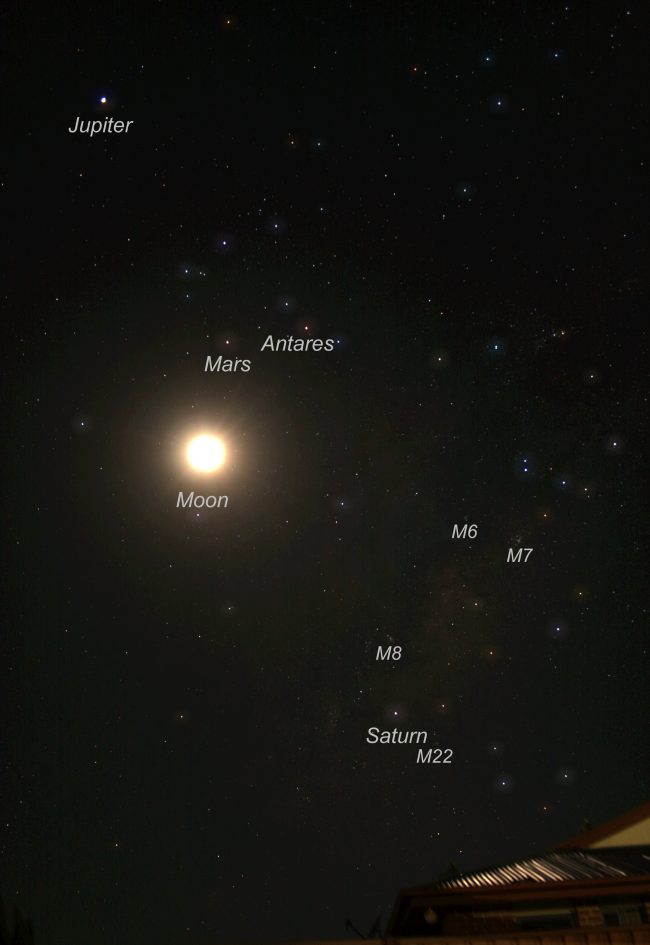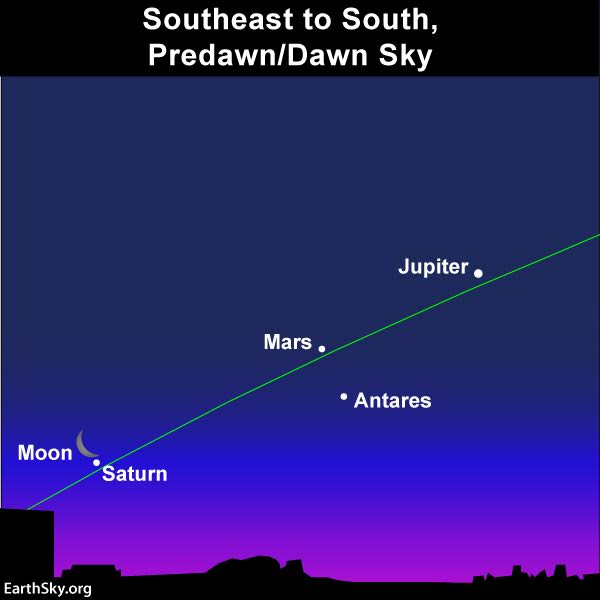Before dawn on February 11, 2018, look for the slender waning crescent moon to pair up with the planet Saturn. You’ll find the pair in the southeast from the Northern Hemisphere (more due east from the Southern Hemisphere). Saturn, the 6th planet outward from the sun, is the most distant world that you can easily see with the unaided eye. It’s one of three planets in the morning sky now.
The other two planets are Mars and Jupiter, and the moon has moved past them each in turn. See our chart for February 7 to 9, or our chart for February 9 to 11. Or look at the chart at the bottom of this post.
Mars is the 4th planet outward from the sun.
Jupiter is the 5th planet outward.
Saturn is the 6th planet outward.
And, of course, Earth is the 3rd planet outward from the sun. Thus these other three planets orbiting the sun outside Earth’s orbit – Mars, Jupiter and Saturn – are called superior planets by astronomers.
All the planets move counterclockwise around the sun, as seen from the north side of the solar system. Or, if you prefer, the planets move clockwise around the sun, as seen from the south side of the solar system. As seen in our sky, Saturn, Mars and Jupiter are moving eastward (toward the sunrise direction) relative to the backdrop stars of the zodiac. Eastward is the usual direction of superior planets, but sometimes, as seen in Earth’s sky, planets do move westward (retrograde).

Saturn – the most distant of the bright planets – travels the most slowly of the bunch around the sun and thus in our sky. Saturn takes nearly 30 years to travel full circle in front of the constellations of the zodiac.
Jupiter – which is farther than Mars but closer than Saturn – takes more time to travel through the zodiac than Mars yet less time than Saturn. Jupiter completes the trip in nearly 12 years.
Mars – just one step outward from Earth – moves more swiftly than either Jupiter or Saturn, taking a little less than two years to complete one trip in front of the backdrop stars.

Because Mars goes so much faster than either Jupiter or Saturn, Mars routinely laps Jupiter and Saturn in Earth’s sky. Mars recently lapped Jupiter on January 7, 2018, and will lap Jupiter again on March 20, 2020. These Mars/Jupiter conjunctions recur in periods of a little over two years.
See photos of the early January 2018 Mars/Jupiter conjunction
Mars will lap Saturn in the relatively near future – on April 2, 2018 – and then will do so again on March 31, 2010. These Mars/Saturn conjunctions repeat in periods of roughly two years.
Jupiter will meet up with Saturn on December 21, 2020, and then again October 31, 2040. Jupiter/Saturn conjunctions recur in periods of about 20 years.

Bottom line: On the morning of February 11, 2018, let the waning crescent moon show you Saturn, the most distant and slowest-moving world that you can easily see with the unaided eye. Jupiter and Mars are also nearby.











